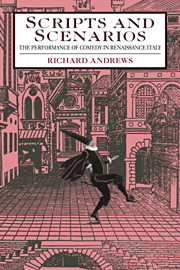Book contents
- Frontmatter
- Contents
- Preface
- Introduction: Italy in the sixteenth century
- 1 Precedents
- 2 The first ‘regular’ comedies
- 3 The second quarter-century, outside Venice
- 4 The second quarter-century, Venice and Padua
- 5 Improvised comedy
- 6 Obstacles to comedy
- 7 Scripts and scenarios
- Notes
- Chronological bibliography of comedies, 1500–1560
- General bibliography
- Index
Introduction: Italy in the sixteenth century
Published online by Cambridge University Press: 29 October 2009
- Frontmatter
- Contents
- Preface
- Introduction: Italy in the sixteenth century
- 1 Precedents
- 2 The first ‘regular’ comedies
- 3 The second quarter-century, outside Venice
- 4 The second quarter-century, Venice and Padua
- 5 Improvised comedy
- 6 Obstacles to comedy
- 7 Scripts and scenarios
- Notes
- Chronological bibliography of comedies, 1500–1560
- General bibliography
- Index
Summary
There was of course no political state called Italy in 1500. From the time of Petrarch, in the fourteenth century, a small educated class had made claims for an ‘Italian’ cultural identity with a Roman heritage superior to that of the ‘barbarians’ beyond the Alps. But such common ground as did exist between communities in Italy was balanced by an equal amount of diversity: from one city to another Italians spoke different vernaculars, obeyed different governments, and were far more used to viewing each other with mistrust and hostility than to pursuing aspirations to any kind of unity. The southern half of the peninsula in particular, a monarchy with a landowning aristocracy and an increasingly backward economy, had very little in common with the urban trade-based civilization of the north and centre. Even those who spoke eloquently of Italian values made no proposals for an Italian state – there had never been such a thing, and in the middle ages it was impossible to imagine one.
In popular cultural history the term ‘Renaissance’ is often linked with concepts of liberation from repressive ‘medieval’ structures (mental, cultural, religious, political). That there were profound changes in this period is beyond question; however, a close look at what was happening to Italian states and society between 1450 and 1600 offers little support for an image of shackles being cast off. Collective committee government characteristic of the city commune was giving way to control by monarchs and princes. Economically too the power was being concentrated at the centre, so the cultural patronage of competitive groups within society was yielding to that of the ruler, court or state.
Information
- Type
- Chapter
- Information
- Scripts and ScenariosThe Performance of Comedy in Renaissance Italy, pp. 1 - 8Publisher: Cambridge University PressPrint publication year: 1993
